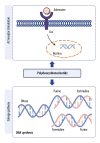Review of Preclinical and Clinical Studies Supporting the Role of Polydeoxyribonucleotide in the Treatment of Tendon Disorders
- PMID: 40189862
- PMCID: PMC11987571
- DOI: 10.12659/MSM.945743
Review of Preclinical and Clinical Studies Supporting the Role of Polydeoxyribonucleotide in the Treatment of Tendon Disorders
Abstract
Tendon disorders are among the most common musculoskeletal conditions, accounting for 30% to 50% of all sports-related injuries. Injured tendons heal slowly and often fail to regain their original structural integrity and mechanical strength, creating significant challenges for physicians. Recently, investigations have reported that polydeoxyribonucleotide (PDRN) plays a key role in promoting tendon healing. For example, preclinical studies indicate that PDRN can enhance tendon repair by inhibiting inflammation and cell apoptosis while promoting collagen production. In clinical studies, the effectiveness and safety of PDRN were also confirmed for managing several conditions, including plantar fasciitis, epicondylitis, Achilles tendinopathy, pes anserine tendinopathy, and chronic rotator cuff disease. In light of these findings, this article aims to review the preclinical and clinical studies that support the role of PDRN in the treatment of tendon disorders. A search was conducted in Medline and PubMed from January 1994 to October 2024 to find relevant research. Ultimately, the review included 3 preclinical studies and 8 clinical studies, involving a total of 318 patients. In conclusion, PDRN is a promising therapeutic option for treating tendon disorders. However, further preclinical and clinical studies are needed to better understand its effects on tendon disorders and to support future clinical applications.
Conflict of interest statement
Figures


Similar articles
-
Does polydeoxyribonucleotide has an effect on patients with tendon or ligament pain?: A PRISMA-compliant meta-analysis.Medicine (Baltimore). 2021 May 14;100(19):e25792. doi: 10.1097/MD.0000000000025792. Medicine (Baltimore). 2021. PMID: 34106615 Free PMC article.
-
Polydeoxyribonucleotide improves tendon healing following achilles tendon injury in rats.J Orthop Res. 2018 Jun;36(6):1767-1776. doi: 10.1002/jor.23796. Epub 2017 Nov 28. J Orthop Res. 2018. PMID: 29094396
-
Polydeoxyribonucleotide and Polynucleotide Improve Tendon Healing and Decrease Fatty Degeneration in a Rat Cuff Repair Model.Tissue Eng Regen Med. 2021 Dec;18(6):1009-1020. doi: 10.1007/s13770-021-00378-5. Epub 2021 Aug 13. Tissue Eng Regen Med. 2021. PMID: 34387852 Free PMC article.
-
Effect of polydeoxyribonucleotide and polynucleotide on rotator cuff healing and fatty infiltration in a diabetic rat model.Sci Rep. 2024 Sep 4;14(1):20623. doi: 10.1038/s41598-024-71206-8. Sci Rep. 2024. PMID: 39232106 Free PMC article.
-
Tendinopathy: injury, repair, and current exploration.Drug Des Devel Ther. 2018 Mar 20;12:591-603. doi: 10.2147/DDDT.S154660. eCollection 2018. Drug Des Devel Ther. 2018. PMID: 29593382 Free PMC article. Review.
References
-
- Darrieutort-Laffite C, Blanchard F, Soslowsky LJ, Le Goff B. Biology and physiology of tendon healing. Joint Bone Spine. 2024;91(5):105696. - PubMed
Publication types
MeSH terms
Substances
LinkOut - more resources
Full Text Sources
Medical

